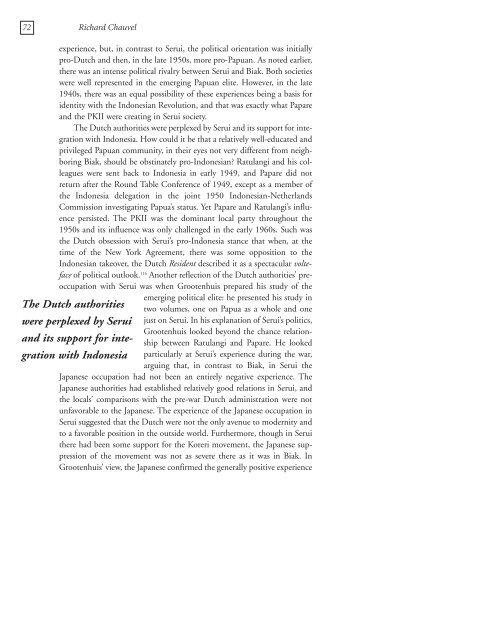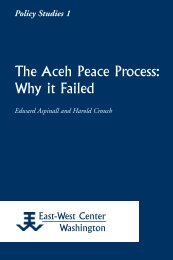Constructing Papuan Nationalism: History, Ethnicity ... - ScholarSpace
Constructing Papuan Nationalism: History, Ethnicity ... - ScholarSpace
Constructing Papuan Nationalism: History, Ethnicity ... - ScholarSpace
- No tags were found...
You also want an ePaper? Increase the reach of your titles
YUMPU automatically turns print PDFs into web optimized ePapers that Google loves.
72 Richard Chauvelexperience, but, in contrast to Serui, the political orientation was initiallypro-Dutch and then, in the late 1950s, more pro-<strong>Papuan</strong>. As noted earlier,there was an intense political rivalry between Serui and Biak. Both societieswere well represented in the emerging <strong>Papuan</strong> elite. However, in the late1940s, there was an equal possibility of these experiences being a basis foridentity with the Indonesian Revolution, and that was exactly what Papareand the PKII were creating in Serui society.The Dutch authorities were perplexed by Serui and its support for integrationwith Indonesia. How could it be that a relatively well-educated andprivileged <strong>Papuan</strong> community, in their eyes not very different from neighboringBiak, should be obstinately pro-Indonesian? Ratulangi and his colleagueswere sent back to Indonesia in early 1949, and Papare did notreturn after the Round Table Conference of 1949, except as a member ofthe Indonesia delegation in the joint 1950 Indonesian-NetherlandsCommission investigating Papua’s status. Yet Papare and Ratulangi’s influencepersisted. The PKII was the dominant local party throughout the1950s and its influence was only challenged in the early 1960s. Such wasthe Dutch obsession with Serui’s pro-Indonesia stance that when, at thetime of the New York Agreement, there was some opposition to theIndonesian takeover, the Dutch Resident described it as a spectacular voltefaceof political outlook. 116 Another reflection of the Dutch authorities’ preoccupationwith Serui was when Grootenhuis prepared his study of theemerging political elite: he presented his study intwo volumes, one on Papua as a whole and onejust on Serui. In his explanation of Serui’s politics,Grootenhuis looked beyond the chance relationshipbetween Ratulangi and Papare. He lookedparticularly at Serui’s experience during the war,arguing that, in contrast to Biak, in Serui theJapanese occupation had not been an entirely negative experience. TheJapanese authorities had established relatively good relations in Serui, andthe locals’ comparisons with the pre-war Dutch administration were notunfavorable to the Japanese. The experience of the Japanese occupation inSerui suggested that the Dutch were not the only avenue to modernity andto a favorable position in the outside world. Furthermore, though in Seruithere had been some support for the Koreri movement, the Japanese suppressionof the movement was not as severe there as it was in Biak. InGrootenhuis’ view, the Japanese confirmed the generally positive experienceThe Dutch authoritieswere perplexed by Seruiand its support for integrationwith Indonesia
















